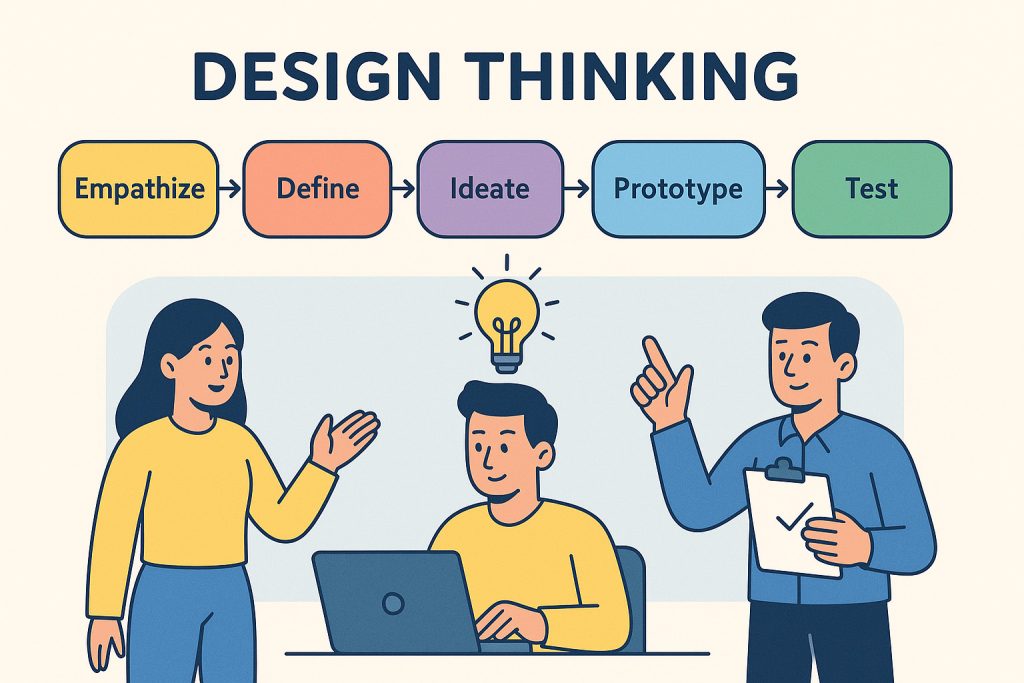Innovation doesn’t happen in a vacuum. The most successful products and solutions emerge when teams step outside their own assumptions and truly understand the people they’re designing for. This is the core philosophy behind design thinking—a framework that has transformed how organizations approach problem-solving by placing human needs at the center of the creative process.
At its heart, design thinking asks a simple but profound question: What if we stopped building products based on what we think people need, and instead built them based on what people actually experience? This shift in perspective has proven revolutionary across industries, from tech startups to healthcare systems, because it acknowledges a fundamental truth—products exist to serve people, not the other way around.
What is the Design Thinking Process?
The design thinking journey unfolds through five interconnected stages, though calling them “stages” might be misleading. Unlike traditional linear workflows, design thinking embraces iteration and flexibility. Teams frequently circle back to earlier phases as they learn new information, much like how agile development operates. The process thrives on continuous discovery rather than following a predetermined path from start to finish.
This fluidity is intentional. Real innovation rarely follows a straight line. As teams test their ideas and gather feedback, they often uncover insights that reshape their understanding of the original problem. A prototype might reveal that the team misunderstood user needs entirely, sending everyone back to the drawing board—and that’s not a failure, it’s progress.
Step 1: Empathize with your users
Everything begins with empathy, and for good reason. Product teams carry their own perspectives, biases, and assumptions into every project. These preconceptions can cloud judgment and lead to solutions that sound brilliant in conference rooms but fall flat with actual users. The empathy phase demands that teams set aside what they think they know and genuinely immerse themselves in the user’s world.
This means observing how people interact with existing solutions, listening to their frustrations without immediately jumping to fixes, and understanding not just what users do, but why they do it. What motivates them? What obstacles do they face? What workarounds have they created? The goal is to develop a rich, nuanced understanding of the human experience you’re trying to improve.
True empathy requires vulnerability—the willingness to discover that your initial assumptions were wrong. But this vulnerability is precisely what opens the door to genuine innovation.
Step 2: Define the problem
Once you’ve gathered deep insights about your users, the next challenge is synthesis. You need to distill all those observations, conversations, and revelations into a clear problem statement that captures the essence of what you’re trying to solve. This isn’t about creating an abstract business challenge; it’s about articulating a human-centered need.
The problem statement serves as your north star throughout the development process. Consider the difference between “We need to increase property management efficiency” and “Property managers need a better, more time-efficient way to manage data across multiple properties.” The second statement centers on real people facing real challenges, which naturally points toward more meaningful solutions.
This definition phase also helps align teams. When everyone shares a common understanding of the problem—rooted in actual user needs rather than internal assumptions—collaboration becomes more focused and productive.
Step 3: Start generating ideas
With a solid problem statement in hand, creativity can flourish. The ideation phase is where possibilities multiply. Teams come together to brainstorm solutions, and the key is to resist the urge to self-censor too early. Every idea, no matter how unconventional, deserves consideration at this stage.
This is the time to think expansively rather than practically. Budget constraints, technical limitations, and strategic priorities will factor in later, but during ideation, the goal is to explore the full landscape of potential solutions. Sometimes the most innovative breakthroughs emerge from ideas that initially seem impractical or unrealistic.
The empathy work you’ve done pays dividends here. Because you deeply understand your users, your team can generate ideas that genuinely address their needs rather than simply repackaging existing features or copying competitors.
Step 4: Build a prototype
Ideas need to become tangible. The prototype phase translates promising concepts into simplified, testable versions that users can actually interact with. Think of this as creating a minimum viable product—something functional enough to gather meaningful feedback without investing enormous resources upfront.
Prototypes serve multiple purposes beyond user testing. They reveal practical considerations about development timelines, resource requirements, and potential obstacles. Your team learns by building, discovering which aspects of the solution prove straightforward and which present unexpected challenges.
The beauty of prototyping in design thinking is that it’s explicitly low-stakes. These early versions are meant to be rough, incomplete, and exploratory. Perfection is the enemy of learning at this stage. The faster you can put something in front of users, the faster you can learn whether you’re on the right track.
Step 5: Test your solution
Testing closes the loop by bringing your prototype back to the people who matter most—your users. This is where you discover whether all that empathy work translated into something that genuinely resonates. User reactions might validate your approach, or they might reveal blind spots you never anticipated.
The insights from testing can redirect the entire process. Maybe users interact with your prototype in unexpected ways, suggesting the problem statement needs refinement. Perhaps their feedback sparks new ideas for features you hadn’t considered. Or maybe you realize you need to deepen your empathy work because you still haven’t quite grasped their experience.
This feedback loop is what makes design thinking so powerful. Rather than treating product development as a one-way journey from concept to launch, it creates continuous opportunities for learning and improvement.
How Can Design Thinking Help Product Managers?
While design thinking originated in the design world, its principles have found enthusiastic adoption among product managers. The framework addresses several challenges that product teams commonly face:
- Cross-functional collaboration: Design thinking naturally brings together different disciplines and perspectives, ensuring that product definition isn’t confined to a single viewpoint
- Moving beyond assumptions: By emphasizing real user conversations over written requirements, teams avoid the trap of treating their assumptions as facts
- Shared understanding: When the entire team participates in the empathy process, everyone develops a deeper understanding of not just what they’re building, but why it matters
Product managers often struggle with balancing competing priorities and stakeholder demands. Design thinking provides a framework for making decisions grounded in user needs rather than internal politics or industry trends. It helps teams distinguish between features that sound impressive and solutions that actually solve problems.
The framework also accelerates learning across teams. When insights about users are shared openly and discoveries are celebrated rather than hidden, organizations build collective wisdom that informs future projects.
The Case for Design Thinking
Every product, regardless of complexity or target market, ultimately serves human beings. Enterprise software affects the daily workflows of real people with real frustrations. Consumer products fit into the routines and aspirations of individuals navigating their lives. Even government services touch citizens who simply want efficient, dignified interactions with public institutions. The common thread is humanity.
Design thinking succeeds because it reorients product development around this fundamental reality. Instead of starting with technology capabilities or market opportunities, it starts with people. This reorientation often reveals opportunities that purely technical or business-focused approaches miss entirely. When you truly understand what frustrates your users, what brings them satisfaction, and how they experience the world, you’re positioned to create solutions that feel almost intuitive—as if they were designed specifically for each individual user, because in a sense, they were.
The framework doesn’t guarantee success, but it significantly increases the odds. Products born from genuine empathy tend to resonate more deeply than those built on speculation. They solve problems users actually have rather than problems teams imagined. They fit more naturally into existing workflows and behaviors. And perhaps most importantly, they demonstrate to users that someone actually listened to and understood them.
Conclusion
Design thinking represents more than just a methodology—it’s a fundamental shift in how we approach innovation. By insisting that empathy comes before ideas, by embracing iteration over rigid planning, and by keeping human needs central throughout the process, it offers a pathway to solutions that genuinely matter. The framework’s non-linear nature might feel uncomfortable for teams accustomed to more structured approaches, but that discomfort often signals exactly where the most valuable learning happens. In a world overflowing with products that nobody asked for, design thinking reminds us that the best innovations emerge when we take the time to truly understand the people we’re trying to help.


